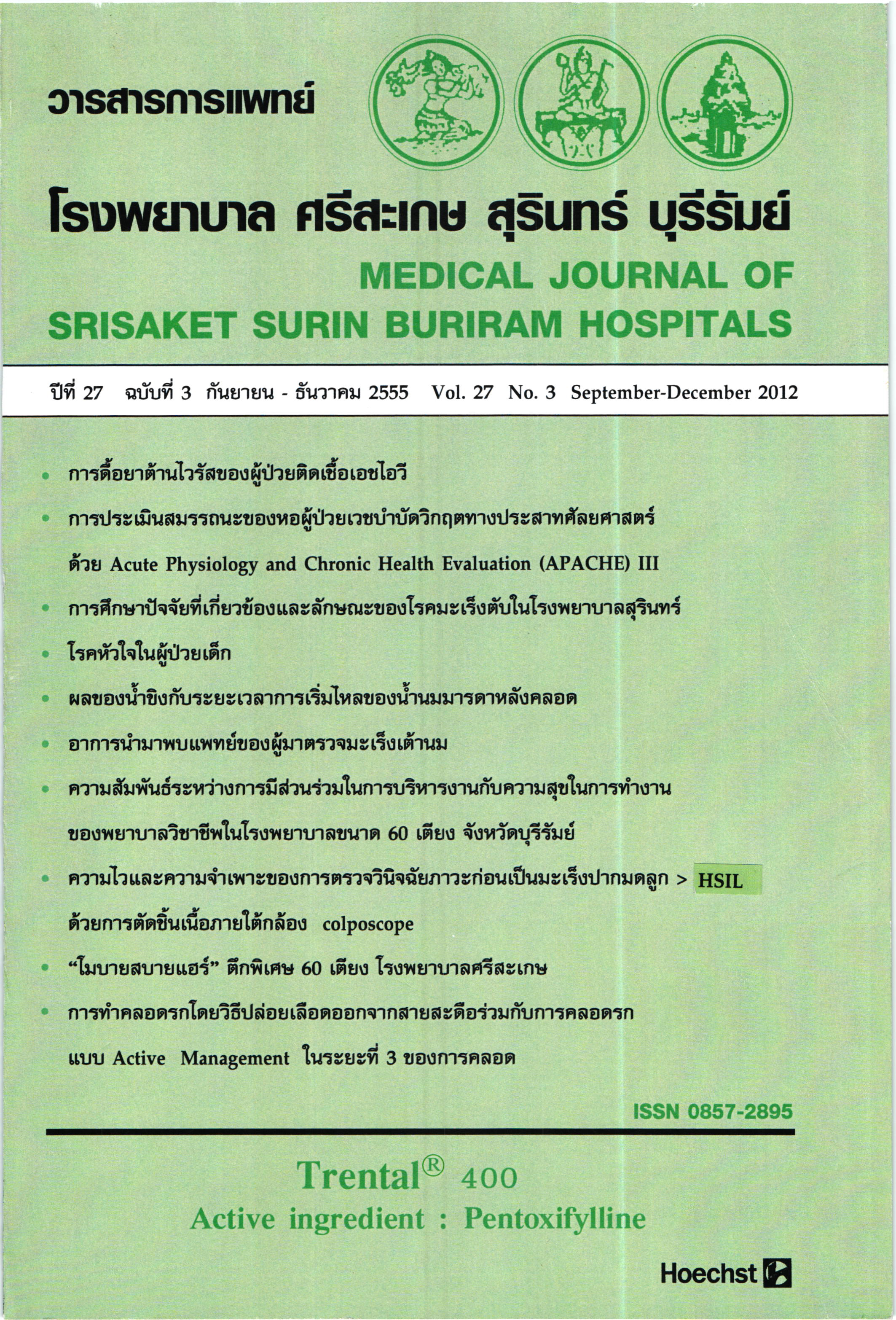ความไวและความจำเพาะของการตรวจวินิจฉัยภาวะก่อนเป็นมะเร็งปากมดลูก > HSIL ด้วยการตัดชิ้นเนื้อภายใต้กล้อง colposcope
Main Article Content
บทคัดย่อ
วัตถุประสงค์: เพื่อศึกษาความไวและความจำเพาะของการตรวจวินิจฉัยภาวะก่อนเป็นมะเร็งปากมดลูก HSIL ด้วยการตัดชิ้นเนื้อภายใต้กล้อง colposcope
ชนิดของการวิจัย: การวิจัยเชิงพรรณนา
สถานที่ทำการวิจัย: กลุ่มงานสูติ - นรีเวชกรรม โรงพยาบาลมหาราชนครราชสีมา
วิธีการศึกษา: ผู้ที่เข้ารับการตรวจและตัดชิ้นเนื้อภายใต้กล้อง colposcope ที่โรงพยาบาลมหาราช นครราชสีมาตั้งแต่ มกราคม 2548 ถึง ธันวาคม 2550 เนื่องจากผลการตรวจ Pap smears ผิดปกติ ตามระบบ Bethesda system 2001 และได้รับการตรวจเพิ่มเติมเพื่อให้ได้ผลทาง พยาธิวิทยาขั้นสุดท้ายจากการตัดปากมดลูกเป็นรูปกรวย หรือตัดมดลูกจำนวน 243 คน
ผลการวิจัย: การวินิจฉัยภาวะก่อนเป็นมะเร็งปากมดลูก HSIL ด้วยการตัดชิ้นเนื้อภายใต้กล้อง colposcope ในกลุ่มผู้ป่วยที่มีผล Pap smear ผิดปกติและได้รับการตรวจเพิ่มเติมด้วยการ ตัดปากมดลูกเป็นรูปกรวยหรือตัดมดลูก มีความไวร้อยละ 81.3 ความจำเพาะร้อยละ 100.0 โดยที่ผู้ป่วยมีอายุตั้งแต่ 21-84 ปี อายุเฉลี่ย 43.1 ปี (SD 10.1) ช่วงอายุที่พบมากที่สุด คือ 41-50 ปี คิดเป็นร้อยละ 35.8
สรุป: ผู้ป่วยทีมีผลการตัดชิ้นเนื้อภายใต้กล้อง colposcope เป็นระยะก่อนเป็นมะเร็งปากมดลูก HSIL ควรต้องทำการตัดปากมดลูกเป็นรูปกรวยเพื่อการวินิจฉัยและหวังการรักษาทุกราย ส่วนในกลุ่มที่เป็น
LSIL หากไม่ได้ทำการตัดปากมดลูกเป็นรูปกรวยควรติดตามการรักษา อย่างใกล้ชิด
คำสำคัญ: ภาวะก่อนเป็นมะเร็งของปากมดลูก HSIL, การตัดชิ้นเนื้อภายใต้กล้อง colposcope, ความไว, ความจำเพาะ
Article Details
เอกสารอ้างอิง
2. Cervical cytology screening. Int J GynaecolObstet [ACOG Practice Bulletin] 2003;83:45:237-47.
3. WilailakS. Epidemiologic report of g ynecologic cancer in Thailand. J GynecolOncol 2009;20:2:81-3.
4. PrasertTrivijitsilp. Cervical cancer screening: interpretation &situation in Thailand. เท: National Cancer Institute, editor. Basic principle of colposcopy and management of abnormal cytologic screening. 1st. ed. Bangkok: Holistic Publishing; 2004.p.l-10.
5. Campion M. Preinvasive disease. In: Berek JS, Hacker NF, editors. Practical gynecologic oncology. 3rd. ed. Phila¬delphia: Lippincott Williams &Wilkins; 2000.p.327-44.
6. Flowers LC, McCall MA. Diagnosis and management of cervical intraepithelial neoplasia. ObstetGynecolClin North Am 2001;28:4:667-84.
7. Wright TC Jr, Cox JT, Massad LS, et al. ASCCP-Sponsored Consensus Conference. 2001 Consensus Guidelines for the management of women with cervical cytological abnormalities. JAMA 2002; 287:16:2120-9.
8. MF Mitchell DS, G Tortolero-Luna. Colposcopy for the diagnosis of squamous intraepithelial lesions: a meta-analysis. ObstetGynecol 1998;91:4:4626-31.
9. Flynn K, Rim DL. Diagnosis of “ASC-US” in woman over age 50 is less likely to be associated with dysplasia. DiagnCyto- pathol 2001;24:2:132-6.
10. SemachaiS. Comparison between colposcopic directed biopsy and conization. MaharatNakhonRatchasima Hospital Medical Bulletin 2000;24:1:13-20.
11. Pengsa P, Udomthavornsuk B. Colposcopy in Srinagarind Hospital. Srinagarind Medical Journal 1986;l:4:167-223
12. Fahey MT, Irwig L, Macaskill P. Meta-analysis of Paptest accuracy. Am J Epidemiol 1995;141:7:680-9.
13. Mitchell MF, Schottenfeld D, Tortolero- Luna G, et al. Colposcopy for the diagnosis of squamous intraepithelial lesions: a meta-analysis. Obstet Gynecol 1998;91:4:626-31.
14. Nanda K, McCrory DC, Myers ER, et al. Accuracy of the Papanicolaou test in screening for and followup of cervical cytologic abnormalities: a systematic review. Ann Intern Med 2000;132:10:810-9.
15. Sawaya GF, Grimes DA. New technolo¬gies in cervical cytology screening: a word of caution. Obstet Gynecol 1999;94:2:307-10.
16. J. Monsonego, J. Pintos, c. Semaille, et al. Human papillomavirus testing improves the accuracy of colposcopy in detection of cervical intraepithelial neoplasia. Int J Gynecol Cancer 2006;16:2:591-8
17. Fine Bruce A., Feinstein Glen I., Sabella Vincenzo. The pre- and postoperative value of endocervical curettage in the detection of cervical intraepithelial neoplasia and invasive cervical cancer. Obstet Gynecol Survey 1999;54:3:174-5.
18. Nick M. Spirtos, John B. Schlaerth, Gerritd'Ablaing III, et al. A critical evaluation of the endocervical curettage. Obstet Gynecol 1987;70:5:729-33.
19. Singhapat p. Sensitivity, specificity and predictive value in diagnosis of precan- cerous or invasive carcinoma of cervix by coiposcope. Medical Journal of Ubon Hospital 2003;25:3:171-82.
20. SathoneBoonlikit. Correlation between colposcopically directed biopsy and large loop excision of the transformation zone and influence of age on the outcome. J Med Assoc Thai 2006; 89:3:299-305.
21. WanmesaBunjongsilp. Comparison between colposcopically directed biopsy and large loop excision of the transformation zone. Thai J Obstet Gynaecol 2008;16:2:123-8.
22. Kumar N, Bongiovanni M, Molliet MJ, Pelte MF, Egger JF, Pache JC. The role of cervical cytology and colposcopy in detecting cervical glandular neoplasia. Cytopathology 2009;20:6:359-66.
23. Buxton EJ, Luesley DM, Shafi Ml. Colposcopically directed biopsy: a potentially misleading investigation. Br J Obstet Gynaecol 1991;98:12:1273-6.
24. Baldauf JJ, Dreyfus M, Ritter J, Philippe E. An analysis of the factors involved in the diagnosis accuracy of colposcopically directed biopsy. Acta Obstet Gynecol Scand 1997;76:5:468-73.


